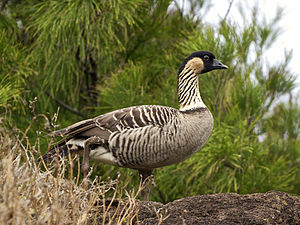Hawaiigans
| Hawaiigans | ||||||||||||
|---|---|---|---|---|---|---|---|---|---|---|---|---|

Hawaiigans ( Branta sandvicensis ) |
||||||||||||
| Systematics | ||||||||||||
|
||||||||||||
| Scientific name | ||||||||||||
| Branta sandvicensis | ||||||||||||
| ( Vigors , 1833) |
The Hawaiigans , Hawaiian Nēnē ( Branta sandvicensis , Syn .: Nesochen sandvicensis ) is a real goose (Anserini) belonging to the sea geese ( Branta ) and is therefore counted in the family of duck birds (Anatidae). Their area of distribution is Hawaii.
The goose is a well-known example of the influence of Europeans and the animals they introduced on the population of an endemic species. The population decreased from around 25,000 animals (1778) to around 30 geese (1950) and increased again to around 1,000 (1999) thanks to protective measures introduced.
Appearance
The Hawaiigans have brown plumage throughout and a head that is darker than the neck. The female is slightly smaller than the male. These weigh an average of 2.2 kilograms, while the females weigh an average of 1.9 kilograms. There is no further gender dimorphism .
When young, the not yet fully grown Hawaiian geese are already very similar to adult birds. Only the neck color is different. They have a light neck color with gray grooves instead of the clay yellow of the adult birds. In the first annual dress there are only inconspicuous differences to the adult birds when the wings are attached. The wings still have noticeably wide hems.
As an adaptation to the subsoil of cooled lava on which it lives, and the almost complete absence of stagnant water in its habitat, the webbed feet between the strong toes are significantly reduced. During the roughly five-week moult , the Hawaiigans lose the ability to fly, which puts them in danger from predators. Hawaiian geese live to be around 25 to 30 years old.
nutrition
As vegetarians, the Hawaiian geese feed exclusively on plant-based food, especially grass , seeds and berries . Due to the sometimes high water content, which is due to the heavy rainfall, they do not need any additional water supply.
habitat
The Hawaiigans live and even breed entirely on land on cold but fertile lava fields at around 1500 to 2500 meters above sea level , where they also raise their young. This habitat has no bodies of water or streams. However, the precipitation is very high and there is regular heavy dew formation. For this reason, the lava fields are densely overgrown with grasses, berry bushes and other flat-growing plants. However, this plant cover is also sensitive to grazing by large animals or use by recreational athletes.
As their name suggests, their habitat are the islands of Hawaii belonging to the USA , more precisely the island of Hawaii itself, where they live mainly on the volcanic cone of Mauna Loa , and the islands of Maui and Kaua'i . As a resident bird , it stays in this habitat all year round.
Reproduction
Males and females mate for life. The breeding season runs from November to February, when the geese build their down-lined nest on the ground. The female lays about four to seven eggs and incubates for about a month. The young animals flee the nest.
Danger
The Hawaiigans are the rarest species of goose in the world. It is critically endangered by hunting, but also by imported predators such as dogs and cats . Feeding by tourists also endangers the animals, as it means they spend more time on the roadsides.
From an estimated 25,000 specimens at the end of the 18th century, their number had been decimated to just thirty free-living specimens by 1950. By rearing the birds in captivity and releasing them again, extinction has been avoided so far; a total of around 2,000 animals have been released back into the wild. The initial successes, however, were largely undone by more intensive agriculture, increasing car traffic and road construction, predatory mammals and loss of habitat . The number of wild animals was around 350 in 1990, plus numerous specimens kept in zoos or wildlife parks. The IUCN again names almost 1,000 animals for 1999. The population continues to rise, but because of the small total population it is still listed as "endangered". Today's conservation efforts focus on protecting the habitat and controlling predators.
literature
- Jonathan Alderfer (Ed.): Complete Birds of North America . National Geographic, Washington DC 2006, ISBN 0-7922-4175-4 .
- T. Bartlett: Ducks And Geese - A Guide To Management . Crowood, Swindon 2002, ISBN 1-85223-650-7 .
- Hartmut Kolbe: The world's ducks . Ulmer, Stuttgart 1999, ISBN 3-8001-7442-1 .
- Erich Rutschke: Wild geese, way of life - protection - use . Parey, Berlin 1997, ISBN 3-8263-8478-4 .
Web links
- Branta sandvicensis in the endangered Red List species the IUCN 2008. Posted by: BirdLife International, 2008. Accessed January 8 of 2009.
- Videos, photos and sound recordings of Branta sandvicensis in the Internet Bird Collection
- Hawaiigans in Basel Zoo ( Memento from September 27, 2007 in the Internet Archive ) with distribution map.
Individual evidence
- ↑ nēnē in Hawaiian Dictionaries
- ↑ Kolbe, p. 119.



